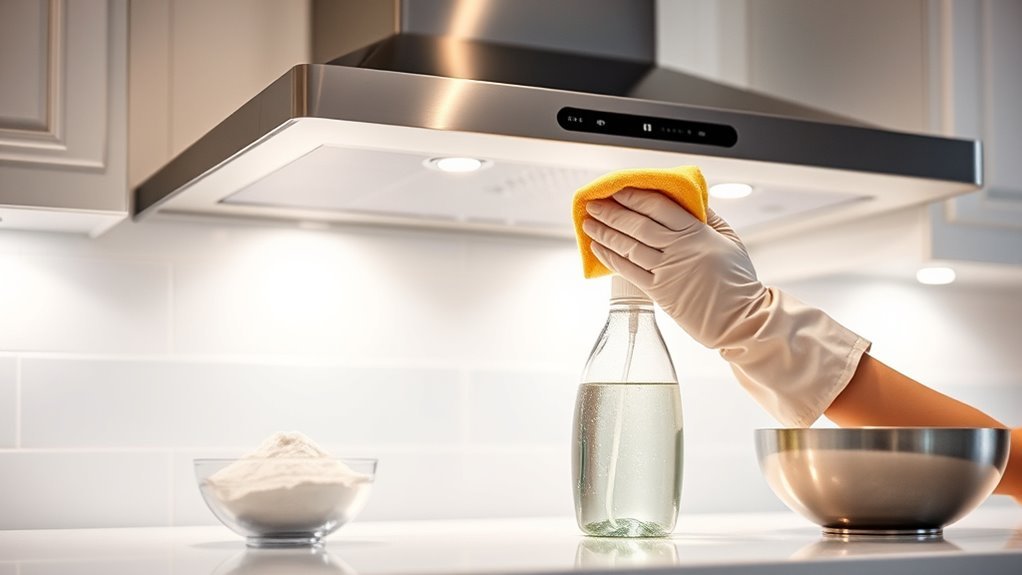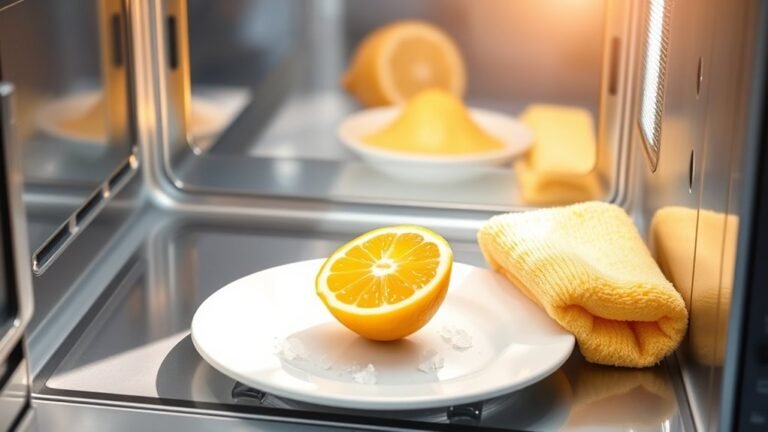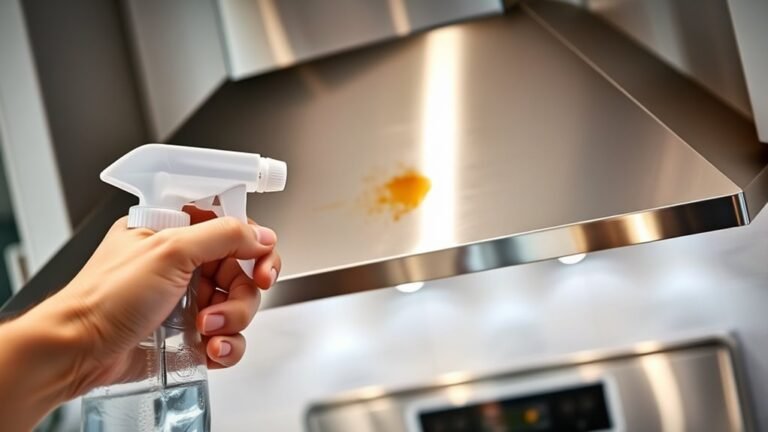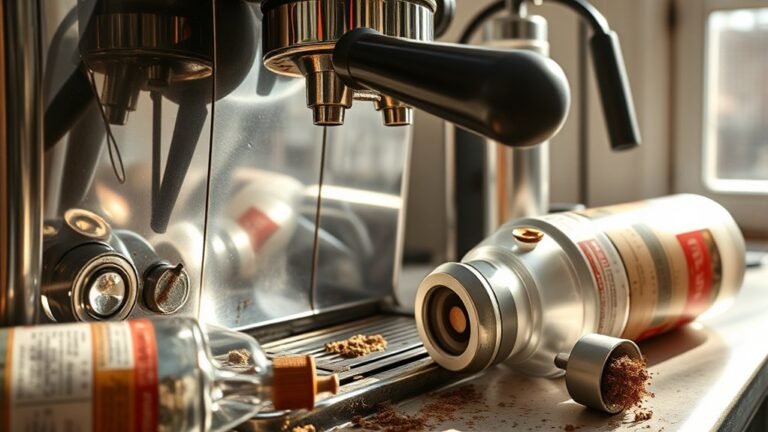How to Clean and Deodorize Your Range Hood
To clean and deodorize your range hood, first gather your cleaning supplies and turn off the power for safety. Remove the filters and soak them in hot, soapy water, then scrub away grease. Wipe down the exterior and interior with a gentle cleaner to avoid damage. After rinsing and drying the filters thoroughly, reassemble everything. Finally, place citrus peels or essential oils nearby to freshen the air. Keep going to discover more tips for maintaining a spotless, efficient range hood.
Gather Necessary Cleaning Supplies

Before you begin cleaning your range hood, make sure you have all the necessary supplies on hand. Freedom starts with being prepared, so grab your supply checklist and gather essential cleaning products like degreaser, dish soap, microfiber cloths, and a soft brush. These tools will help you tackle built-up grime without damaging surfaces. You don’t want to stop midway because you’re missing something vital. Having everything ready means you can clean efficiently and get back to your day without hassle. Remember, the right cleaning products make all the difference—choose ones safe for your hood’s material. By organizing your supply checklist now, you’re setting yourself up for a smooth, effective cleaning session that keeps your kitchen fresh and your range hood running smoothly.
Turn Off the Power to Your Range Hood
To guarantee your safety, always turn off the power to your range hood before you start cleaning. This essential step guarantees you avoid electrical shocks and protects the appliance’s delicate components. Taking safety precautions means disconnecting all power sources to work freely and confidently.
Here’s how to do it:
- Locate your home’s circuit breaker panel
- Identify the breaker controlling your range hood
- Switch the breaker to the “off” position
- Double-check the range hood’s power is completely off
- Unplug the unit if it has a power cord
Remove the Filters and Soak Them

First, identify whether your filters are metal mesh, charcoal, or baffle types, as each requires different care. You’ll want to soak metal and baffle filters in a hot, soapy water solution or a mix with baking soda for effective grease removal. Let them soak for about 15 to 30 minutes to loosen grime before scrubbing gently.
Filter Types Explained
Filters play an essential role in keeping your range hood functioning efficiently by trapping grease, smoke, and odors. Understanding filter types helps you decide when to perform filter maintenance or consider filter replacement. Most range hoods use one of these common filters:
- Mesh filters: Made of aluminum layers; washable and reusable.
- Baffle filters: Stainless steel, designed to capture grease efficiently.
- Charcoal filters: Used for recirculating hoods to absorb odors.
- Combination filters: Mix of mesh and charcoal for versatile protection.
- Disposable filters: Single-use, replaced regularly for convenience.
Knowing your filter type lets you free yourself from worrying about clogged filters and guarantees your kitchen stays fresh and smoke-free. Regular care keeps your range hood working at its best, giving you the freedom to cook without limits.
Soaking Solutions Recommended
Although it might seem tedious, removing your range hood filters and soaking them is one of the most effective ways to break down grease and grime. Soaking mixtures designed for filter maintenance free you from scrubbing endlessly. You just immerse the filters, let the solution work its magic, and then rinse. Here’s a quick guide to soaking mixtures that set you free from stubborn buildup:
| Soaking Mixture | Ingredients | Best For |
|---|---|---|
| Baking Soda Solution | Baking soda + hot water | Heavy grease |
| Vinegar Bath | White vinegar + warm water | Odor removal |
| Dish Soap Mix | Degreasing dish soap + water | Daily filter upkeep |
Choose your mix, soak, rinse, and enjoy effortless filter maintenance that keeps your kitchen fresh and free.
Soaking Duration Tips
One to two hours is usually enough time to let your range hood filters soak and loosen grease effectively. This soaking duration strikes a balance between soaking effectiveness and saving you time, giving you the freedom to focus on other tasks. For tougher grime, you might extend soaking up to 4 hours, but avoid overnight soaking to prevent damage. Remember, consistent filter maintenance guarantees your range hood runs smoothly and safely.
Keep these tips in mind for ideal soaking:
- Use warm soapy water or a degreasing solution
- Fully submerge filters to maximize contact
- Stir occasionally to break up buildup
- Rinse thoroughly after soaking
- Dry filters completely before reinstalling
With these simple steps, your filters will be fresh and ready, letting you breathe easier and cook freely.
Clean the Exterior Surface

When cleaning your range hood’s exterior, pick cleaning agents that won’t damage the surface. Use soft cloths or sponges to avoid scratches, and make wiping down a regular habit to keep it looking fresh. This simple routine helps prevent buildup and keeps your kitchen smelling clean.
Choose Appropriate Cleaning Agents
Since the exterior surface of your range hood is exposed to grease and grime, choosing the right cleaning agents is essential to avoid damage while effectively removing buildup. You want cleaning agents that work hard but respect your appliance and the environment. Consider these eco friendly options that keep your space fresh and green:
- Mild dish soap mixed with warm water
- White vinegar diluted with water
- Baking soda paste for tougher spots
- Commercial eco-friendly degreasers labeled safe for kitchen appliances
- Essential oils like lemon or tea tree for natural deodorizing
Selecting gentle yet effective cleaning agents lets you maintain your range hood’s shine without harsh chemicals. You’ll enjoy a cleaner kitchen and peace of mind, freeing you from worries about toxic residues or surface harm.
Use Soft Cleaning Tools
Soft cleaning tools are your best allies for maintaining the exterior surface of your range hood without scratching or damaging it. You’ll want to rely on soft bristle brushes to gently remove stubborn particles and microfiber cloths to wipe away grease and dust effectively. These tools let you clean freely without fear of harm.
| Tool Type | Best Use | Benefit |
|---|---|---|
| Soft Bristle Brush | Dislodging grime in crevices | Gentle on surfaces |
| Microfiber Cloths | Wiping and polishing | Lint-free, non-abrasive |
| Soft Sponges | Light scrubbing | Prevents scratches |
Use them regularly to keep your range hood looking fresh and scratch-free, embracing the freedom of easy, effective cleaning.
Wipe Down Regularly
Regularly wiping down your range hood’s exterior helps prevent grease buildup and keeps it looking clean. Sticking to a consistent cleaning frequency makes maintenance easier and extends your hood’s lifespan. Here are some maintenance tips to keep in mind:
- Use a damp microfiber cloth to gently remove grease and dust
- Apply a mild detergent or vinegar solution for tougher spots
- Wipe in circular motions to avoid streaks
- Dry immediately with a clean, dry cloth to prevent water marks
- Schedule wiping at least once a week or after heavy cooking sessions
Scrub the Filters Thoroughly
Grab a brush and some warm, soapy water to tackle the grease and grime trapped in your range hood filters. Scrubbing the filters thoroughly is essential to keep your kitchen air fresh and your hood working efficiently. Don’t rush this step—let the brush reach every nook to break down stubborn buildup. Regular filter maintenance not only improves airflow but also extends your filter’s life, saving you from frequent filter replacement. If you notice the filters are damaged or too clogged despite cleaning, it’s time to swap them out for new ones. Staying on top of this routine gives you the freedom to cook without worrying about lingering odors or reduced ventilation. Clean filters mean your kitchen stays inviting and your range hood performs like new.
Clean the Interior of the Range Hood
Once you’ve given the filters a good scrub, it’s time to turn your attention to the interior of the range hood. Proper interior cleaning is key to effective range hood maintenance and keeping your kitchen fresh. Start by unplugging the unit for safety. Then, grab a soft cloth or sponge with warm soapy water and gently wipe down:
After cleaning filters, unplug your range hood and gently wipe the interior with warm soapy water for freshness.
- Grease-coated surfaces
- Fan blades and motor housing
- Light covers and bulbs
- Vent openings
- Interior walls and corners
Avoid harsh chemicals that can damage finishes or components. Pay special attention to stubborn grease spots but keep the cleaning light to prevent damage. This step frees your range hood from hidden grime, improving airflow and performance. Regular interior cleaning guarantees your kitchen stays odor-free and your range hood runs smoothly—granting you the freedom to cook without worries.
Rinse and Dry the Filters
After scrubbing away grease and grime, you’ll want to rinse your filters thoroughly with warm water to remove any remaining soap and debris. Make sure to hold each filter under steady water flow, allowing the warm water to flush out trapped particles. Proper filter maintenance not only keeps your range hood operating efficiently but also prevents unpleasant odors. Once rinsed, shake off excess water and let the filters air dry completely before reinstalling them. This step is essential to avoid moisture buildup that can lead to mold or damage. Stick to a consistent cleaning frequency—ideally every one to three months depending on your cooking habits—to enjoy a fresh, odor-free kitchen. Keeping this routine liberates you from stubborn grease and keeps your range hood in peak condition.
Reassemble the Range Hood
Two key steps remain before your range hood is ready to use again: reassembling the filters and securing all components in place. Embrace the freedom of a clean cooking space by tackling the range hood assembly with confidence. Start by carefully positioning the dried filters back into their slots, ensuring proper filter replacement. Then, follow these steps to finish up:
- Align the filters so they fit snugly without gaps
- Snap or screw any fasteners to lock filters securely
- Reattach any grease trays or covers removed earlier
- Double-check the fan and light switches for clear access
- Wipe down the exterior for a polished look
Use Natural Deodorizers to Freshen the Air
Although cleaning your range hood removes grease and grime, lingering odors can still affect your kitchen’s atmosphere. To truly freshen the air, try natural deodorizers that give you freedom from harsh chemicals. Place citrus peels—like lemon, orange, or grapefruit—in a small bowl near your range hood. Their bright, zesty scent naturally neutralizes odors and lifts the room’s energy. You can also use essential oils by adding a few drops to a cotton ball or diffuser nearby. Scents like eucalyptus, lavender, or tea tree not only smell fresh but also have antibacterial properties. These simple, natural solutions keep your kitchen air crisp and inviting without restricting your choice to synthetic sprays. Embrace these easy steps to maintain a breathable, fresh space that feels truly yours.
Frequently Asked Questions
How Often Should I Clean My Range Hood Filters?
Wondering how often you should clean your range hood filters? Following frequency guidelines is key to keeping your kitchen fresh and your hood working efficiently. Generally, you’ll want to clean metal filters every month or two, while charcoal filters might need replacing or cleaning more often depending on usage. Staying on top of filter maintenance frees you from lingering odors and grease buildup, giving you the freedom to cook without worry.
Can I Use a Dishwasher to Clean Range Hood Filters?
You can often use your dishwasher to clean range hood filters, but it depends on the filter materials. Metal filters, like aluminum or stainless steel, usually handle dishwasher safety just fine. However, charcoal or other non-metal filters might not hold up well. Always check your manufacturer’s guidelines before tossing them in the dishwasher. This way, you’re free to clean without worrying about damage and keep your kitchen fresh effortlessly.
What Type of Range Hood Filter Is Best for My Kitchen?
Choosing the best range hood filter depends on your cooking style. If you want something durable and easy to clean, metal filters are your go-to—they trap grease well and can be washed repeatedly. But if you’re after odor control and don’t mind replacing filters periodically, charcoal filters are perfect since they absorb smells effectively. Think about your kitchen freedom: metal for long-term use, charcoal for fresh air.
How Do I Know if My Range Hood Needs Repairs?
You’ll know your range hood needs repairs if you notice signs like unusual noises, poor ventilation, or grease buildup that won’t go away. Common issues include a malfunctioning fan motor, faulty lights, or clogged filters that reduce efficiency. If you’re feeling restricted by your hood’s performance, don’t ignore these signs. Addressing repairs early lets you enjoy a freer, cleaner cooking space without hassle or smoke lingering around.
Are There Any Safety Tips for Maintaining a Range Hood?
When maintaining your range hood, safety precautions are a must. Always unplug it before starting any work to avoid electric shocks. Use gloves to protect your hands from sharp edges. Keep a maintenance checklist handy, including cleaning filters, checking fan operation, and inspecting electrical connections regularly. This way, you stay free from unexpected issues and keep your kitchen safe and efficient without hassle. Staying proactive guarantees your range hood serves you well.






